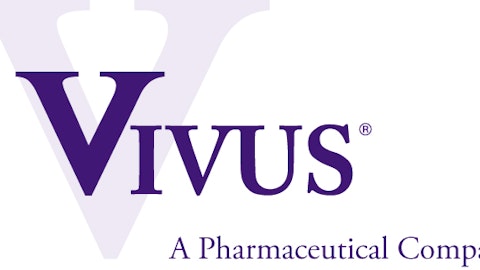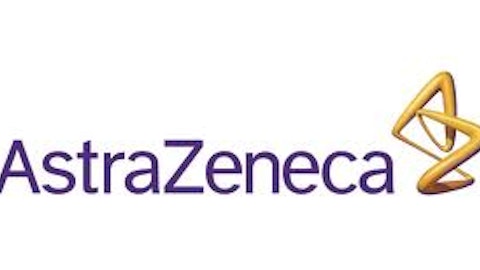LONDON — Though there isn’t one surefire way to tell if a company is worth investing in, there are a few quick ways to see if you’re looking at a dud or a stud.
You don’t need a finance degree or a week off work to do this. You just need 20 minutes and a web browser, and you’ll be on your way to finding your next stock.
Today I’ll put GlaxoSmithKline plc (ADR) (LSE:GSK) (NYSE:GSK) under the microscope to show you what I’m talking about.
I’m going to zoom in on three key things to know — and for the most part, like — about one of the world’s truly diversified health care companies.
Is GlaxoSmithKline plc (ADR) (LSE:GSK) (NYSE:GSK) making money?
In business, as in personal finance, how much money coming in is essential to being financially secure.
This money coming in is cash flow, and looking at a company’s cash flow gives us — as current or potential shareholders — a sense of how well that company is doing at selling its wares.
In the case of Glaxo, looking at its cash flow will give us a good sense of how well its prescription treatments are selling, as well as how successful Glaxo is at moving its consumer-health products — think toothpaste and over-the-counter medicines — off the shelves.
Looking at Glaxo’s cash flow over the past three years reveals, to me, a well-diversified business — but one with some challenges ahead of it.
In 2012, Glaxo posted free cash flow of 2.9 billion pounds — down meaningfully from 4.9 billion pounds in 2011 for one key reason: Glaxo had to shell out more than 2.6 billion pounds during 2012 to settle a lawsuit with the U.S. Justice Department (the largest legal payment ever by a pharma company!).
Although the cash flow figures reflect a downward trend for Glaxo — cash flow also fell from 2010 to 2011 — we must remember that we’re still looking at a company that’s generating billions of pounds of profit each year.
And most investors are initially drawn to Glaxo for its above-average dividend yield. With the 10-year gilts offering less than 2% these days, it’s easy to understand why Glaxo’s 4.2% dividend yield is appealing.
In fact, Glaxo has paid out more than 3 billion pounds per year to shareholders since 2010, having reached a total payout of 3.8 billion pounds in 2012 — or 74 pence per share.
What’s more, investors have also benefited from Glaxo repurchasing more than 2 billion pounds worth of its own shares during each of the last two years. That looks set to continue in 2013, as Glaxo says it plans to repurchase another 1 billion to 2 billion pounds of its own shares.
The benefit to shareholders here is indirect, but with a reduced share count, investors will see their ownership in the company grow. And with consumer drinks Ribena and Lucozade up for sale, there is a good chance Glaxo will use the cash to continue the share repurchases.
Remember, companies that are making money can typically afford to reinvest in the business, repurchase shares, or return some of those profits in the form of dividends to you and me as shareholders, as is the case with Glaxo.
How much debt does it have?
While you and I work hard to live debt-free, most companies that we invest in do carry debt. Sometimes a lot of debt. But that’s not necessarily a bad thing.
When looking at a company’s net debt — its borrowings minus the cash it has in the bank — you also want to see how easily it can pay down that debt.
In Glaxo’s case, the company carried 18.3 billion pounds of debt at the end of 2012 — up from 14.9 billion pounds in 2011 and 15.1 billion pounds in 2010.
And when you factor in Glaxo’s 4.2 billion pounds in cash it holds on the balance sheet, you see that Glaxo is carrying net debt of 14.1 billion pounds.
While investing in a company that carries billions in debt may seem scary, remember that the company is also making billions each year.
And in Glaxo’s case, the company generated very healthy operating profits of 7.4 billion pounds in 2012, and that number reflects a comfortable debt-to-operating-profit ratio of about 1.9:1.
Is GlaxoSmithKline plc (ADR) (LSE:GSK) (NYSE:GSK) going to PAY you dividends?
After looking at the money a company makes alongside what it owes, there’s one final number to pay attention to in the case of income-generating shares such as Glaxo.
Dividend growth.
A dividend is cash paid to you as a shareholder of the company. You want to look for companies with a good track record of dividend growth and a good strong balance sheet to cover that dividend.
Glaxo has raised its total dividend payout nicely over the past three years, from 63 pence per share in 2010 to 67 pence in 2011, all the way up to 74 pence per share in 2012.
Better still, the trend continues: management hiked the quarterly dividend another 6% to 18 pence per share in the first quarter of 2013.
With a current yield of about 4.2%, GlaxoSmithKline plc (ADR) (LSE:GSK) (NYSE:GSK) offers shareholders a generous income stream. As long as the company can grow earnings at a modest single-digit growth rate, dividend growth should follow, if GlaxoSmithKline plc (ADR) (LSE:GSK) (NYSE:GSK)’s long history of dividend increases is any guide.
And the verdict is in on GlaxoSmithKline!
Of course, anyone investing in Glaxo today knows that it’s all about what the company can do from here.
Share-price performance has been solid, but not spectacular. Glaxo is up 24% in the past year, against 27% for the FTSE 100. Over the past three years, Glaxo is up about 52% against 33% for the index
That growth is pretty impressive, but most people invest in Glaxo — as I have — as a foundational, dividend-paying share for your portfolio.
And great news for interested investors — my fellow Motley Fool analysts seem to agree with me!
The article 3 Things You Need to Know About GlaxoSmithKline originally appeared on Fool.com and is written by Jill Ralph.
Jill Ralph owns shares of GlaxoSmithKline. The Motley Fool recommends GlaxoSmithKline.
Copyright © 1995 – 2013 The Motley Fool, LLC. All rights reserved. The Motley Fool has a disclosure policy.




